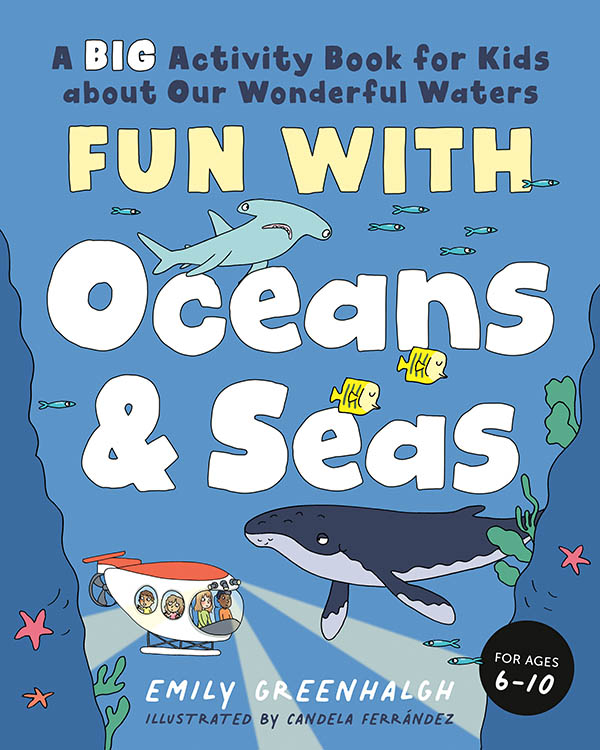
Emily Greenhalgh (’12) turned her passion for marine biology into a career as a science communicator. Photo courtesy of Emily Greenhalgh
Writing Science for Kids
Fun With Oceans & Seas, a new book by alum Emily Greenhalgh, takes an engaging approach to marine biology
“Kids are scientists,” says Emily Greenhalgh. “They always want to poke something and see how it works.”

Greenhalgh (’12) speaks from experience. She spent her childhood exploring the coastline near Cranston, R.I., where she studied tide pools and scoured the beaches for sea glass. That curiosity has fueled a career in science communications and a new book: Fun With Oceans & Seas: A Big Activity Book for Kids about Our Wonderful Waters (Z Kids, 2023), released in September.
The ocean is a perfect subject for engaging the curiosity of children, she says. “They’re little sponges that want to soak up as much information as possible.” A visit to the beach can be a lesson in biology, geology, and—with the tides in constant motion—even astronomy. But the ocean is also a source of mystery. “We know more about the surface of Mars than we do about the bottom of the ocean,” Greenhalgh says. That’s one of her favorite facts in a book that’s packed with them (see “Five Fun Facts” below for more favorites).
The Life Aquatic
“Every kid goes through a marine biologist phase,” Greenhalgh says. “I just never grew out of it.” Greenhalgh stayed local for college, studying marine biology at the University of Rhode Island. After a couple of years working as an observer on commercial fishing boats and in laboratories, she headed to COM for a master’s in science journalism. Since then, she has worked as a writer at the National Oceanic and Atmospheric Administration (NOAA) and the New England Aquarium. Now, she’s the digital media manager for the Marine Biological Laboratory in Woods Hole, Mass., where she’s responsible for writing, photography, video, and social media. She’s tagged sharks in Florida’s Dry Tortugas and vacationed in Antarctica.
Translating complex science for a general audience is more important than ever, Greenhalgh says. With the urgency of climate change and the growing threat of misinformation, the science community has become more focused on communicating outside of their own academic bubble, she says. Potential funders also see communication and publicity as priorities, and they often ask for social media analytics and public relations plans as part of research grant applications.
Every kid goes through a marine biologist phase. I just never grew out of it.
Emily Greenhalgh
“I write a lot about climate change, which can be very depressing,” Greenhalgh says. “It’s important to realize that there’s a lot of really amazing stuff around us and to take the time to look at it and appreciate it.”
So, when editors from Penguin Random House reached out to her in 2022, she was happy to jump on a video call to discuss the possibility of writing a kids’ book. It just so happened that she’d worn a dress covered in octopuses that day. “Your vibe is really helping your case,” one of the editors told her. She got the job.
Inspiring a Smart Audience
Greenhalgh was responsible for writing about 7,000 words for the book, covering 5 oceans and 20 seas, plus plants, creatures, reefs, glaciers, and shipwrecks. The book is part of the publisher’s Fun With… series, which includes titles about the 50 states and the national parks and is built around crossword puzzles, code-cracking games, connect-the-dots, and other activities. That meant Greenhalgh also had to figure out how to convey facts through those formats. Designing a word search might seem like a far cry from explaining climate change, but she drew on some advice she’d received from a COM professor when pitching an idea for a kids’ article: If you dumb it down, kids are going to know. They’re smart. You might have to use smaller words, but they don’t want to be talked down to.
Greenhalgh still remembers some of the influences from her childhood. She read the National Wildlife Federation’s Ranger Rick magazine and saw The Little Mermaid in the theater. “I wanted to dye my hair red, like Ariel,” she says. Later, Greenhalgh watched The X-Files, which makes her a self-proclaimed product of “The Scully Effect,” the phenomenon of the character Dana Scully, a medical doctor-turned FBI agent, inspiring girls to pursue careers in science, technology, engineering and mathematics (STEM).
If her book can inspire the kids who read it, Greenhalgh will be thrilled. “I want little kids to pick it up and be like, ‘The ocean is so much cooler than I thought it was!’” she says. “Talking to people, making them understand, putting data in a way that is not scary—I feel like it’s so important. People don’t care about what they don’t know.”
Five Fun Facts
Emily Greenhalgh was able to use many of her favorite science facts while writing Fun With Oceans & Seas—and she even picked up a few new ones in her research. Here are five of her favorites:
- More than 80 percent of the ocean is unexplored.
- The largest animal to ever live is still alive today: the blue whale, bigger than the biggest dinosaur.
- The Great Barrier Reef can be seen by astronauts from the International Space Station.
- Scientists believe that 70 percent of all sand in the Caribbean and Hawaii is parrotfish poop.
- The tallest tsunami ever recorded was 1,700 feet high, in Alaska in 1958.



